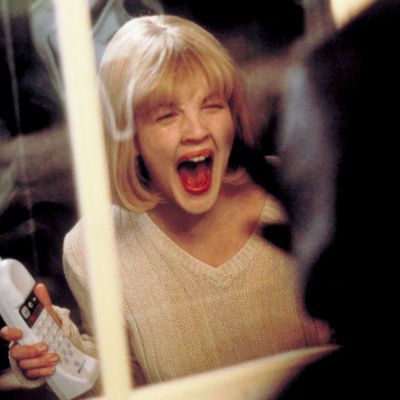
Kevin Williamson was a struggling actor in his 20s when he decided to try his hand writing the sort of slasher films he grew up loving. By then, he’d watched Halloween and Friday the 13th so many times that he knew every twist of the camera and jump scare by heart. “I wanted to write a horror movie that I’d want to watch,” he said. “But how do you scare an audience when all the magic tricks have been exposed?”
The answer, as it turned out, was Scream, the self-aware, meta horror ’90s hit about a group of teenagers who have watched all the horror movies, and then, one by one, are murdered. More than 20 years later, Scream is still scary. And everything that makes it great is on display in its electric opening scene: a twisted game of horror trivia, a beautiful girl, a pair of gruesome murders, a telephone ringing in an isolated house at night.
For Vulture’s package on the 100 Scares That Shaped Horror, Williamson shared the story behind how he conceived of the film’s iconic opening scene.
I knew all these horror movies inside and out, and I kept thinking: How do you scare an audience that grew up on VHS, that’s watched these movies over and over again? So I thought, we comment on the rules and then subvert them a bit — or, sometimes, we follow them exactly, and then you never know what you’re going to get. When you put your star actress in the opening scene and kill her, you’re putting everyone off their game.
I wanted the Janet Leigh moment. I always felt that once you killed the star of the movie, all bets are off. When we first did the movie, Drew was attached to play Sidney Prescott, and then we were trying to find a bigger actress to play the opening part. At the time, Alicia Silverstone was huge, coming off of Clueless, but then Drew told us, “I really just want to play the opening scene. That’s my favorite part of the movie.” And that was great by us.
I wanted her to be the classic, ingénue teenage girl, with that innocent face, in a white sweater and blond hair. At the time, Drew had jet black hair, and she’d just dyed it, so we couldn’t dye it back to blond. She had to wear a wig. I remember Wes saying, “let’s just think of her as a Catholic school girl. She does everything right, and she’s a perfect little girl, and she’s about to be eviscerated, and that’s it.” And I was like, “okay, works for me!” I just wanted the audience to relate to her on some emotional level, and that’s why casting was so important. You meet her and two minutes later she’s in danger. We need an instant connection.
That’s what Drew brought to it. You instantly related to her and the fear dancing in her eyes as she starts to get nervous and uncomfortable, and she starts to realize this is going south. It’s a great performance. Her body language in the beginning is very swirly and rhythmic. She pulls a knife out and slides it back in to the butcher block. She spins around. And then the minute she gets scared, her shoulders go inward and everything changes. If you watch it again, just watch her body language as it transforms.
Drew was very adamant that she didn’t want to see the man playing the voice. We had him in a separate tent, and we had to keep him away from Drew’s vision. She just wanted to hear the voice and be scared by the voice. She didn’t want to attach a face to it. She didn’t want to get one word wrong. And I’m talking even about her screams and her breaths and her “No! No! No!” She was on the mark. I was blown away by her rhythm. I’m always happy to have actors ad-lib, because that can be some of your best stuff and Matthew Lillard was a genius at it. But she was so careful.
A big inspiration for me was the opening scene of When a Stranger Calls with Carol Kane. It was one of those relentless scenes with mood and atmosphere and a slow build. In my first pass of the scene, Casey Becker was actually babysitting. Once I’d written it, I realized it wasn’t necessary. Really, the scene was about Casey’s boyfriend, who was outside strapped to a chair. And it was about the game, and the premise, and the setup, and the conceit of the world we’d created. I wanted it to be just long enough that the audience thinks she might survive it. And the only way to do that was to let it go on just a tad longer than it should. An opening scene shouldn’t go on longer than ten minutes, and this one went on much longer than that.
Once I latched onto the game, I do remember I had written way too many questions. Eventually I narrowed it down, and focused in on the trick question [“Name the killer in Friday the 13th.”] I had much harder questions in the beginning, and the scene really went on forever.
From the page to the screen, we changed some things based on the house and the location. Like, how she got out of the house, and when she looked up at the window and saw that he was staring down at her. All of those moments were created on the spot because of the house. We wanted a house with windows everywhere. Wes was always big on shooting on location. He always wanted to see out the windows, so that the audience could see the danger, or not see the danger that was lurking out there. Prior to the shooting, I went with him to the house and we walked it, and I went and rewrote the action scenes based on his blocking. It was my first experience of realizing that what I saw in my head was never what it actually is. That was a big learning experience, of learning how to let things go. But this is the process. It’s a group effort. It was mostly, “oh wow, this is not what I envisioned in my head — this is better.”
It took them five nights to shoot it. It was my first movie, and I had no idea what I was doing. I was just standing there, asking constant questions. Like, “what’s that? That’s a crane!” I remember the producer looking at me at one point and saying, “you might want to stop asking questions. He’s not here for you. This isn’t a study session.” And Wes was like, “no it’s cool, it’s cool.” I found Wes to be the most calming presence on the set. He saved all his dark impulses for the work. He was just this quiet captain. He always had a great connection with the actors because he was so quiet and intimate with them.
Watching the scene come to life was very emotional. I called my mom and dad on the phone and let them hear Wes screaming “cut!” It was a big deal. It was the beginning of my career. And you just never know how it’s going to play out — it was such a question mark. How lucky was I that my first movie would be something like that? Scream was just everything and more to me. And it still is.


